Quentin Tarantino Takes His Latest Bloody Show on the Road
This review was originally written for TwitchFilm.com, a site with a readership that’s generally very interested in the work of Quentin Tarantino. While I personally continue to find unique value in his work, I am sympathetic to those who are not on board. Many acknowledge his talents, but are unable to trust him. Others simply find his work too gleefully twisted, too fundamentally disturbing. So for that reason, I will mention that THE HATEFUL EIGHT is unlikely to change anyone’s mind. This review was written from the perspective of a fan (a discerning one, but still a fan), for other likely fans. It’s a more tongue-in-cheek take rather than a detailed analysis, which is fitting for this particular film. I hope you enjoy it.
——
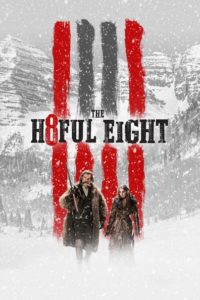 Quentin Tarantino is keeping count.
Quentin Tarantino is keeping count.
Of his own filmography, that is. He has been for some time. On the poster for 2003’s Kill Bill: Vol. 1, he prominently touted it as his 4th film. Seeing, however, that that 4th film was cut into two separate films, and then his next effort, Death Proof, was technically one half of a bigger film, that’s where conventional numbering would stop making sense.
But, we don’t look to Quentin Tarantino to maintain convention. When Tarantino hit the scene with Reservoir Dogs all those years ago, he shook things up in the indie film world. With Pulp Fiction a few years later, he went seismic. Ever since, we’ve been living amid the ultra-cool, cinephile, self-indulgent aftershocks.
As evidenced in his latest work, The Hateful Eight, his style (crackling dialogue, bursts of well-timed violence), nor his indulgence with his obvious obsessions (shots of feet, the N-word) has not dulled nor tamed.
The Hateful Eight is a tension-filled chamber piece that also manages to be a sprawling period epic. Set in the post-Civil War years, the film is an ensemble piece that functions as gripping even when very little is happening. But, something is always happening… You just have to be listening. Yes, his characters do like to talk, and yes, so does he (most unfortunately). Tarantino has a sordid history of being nauseating as an interview subject off-screen, particularly when he’s convinced that his historic revenge fantasies are capital-I Important.
“The Hateful Eight” is a tension-filled chamber piece that also manages to be a sprawling period epic.
Thankfully, The Hateful Eight itself is neither a revenge fantasy nor does it bear the marks of anything “Important”. It’s simply a very colorfully and precisely spoken ode to the super-widescreen spectacles of yore, infused with Tarantino’s standard level of splattery bloodshed, twisted sensibility and badassery.
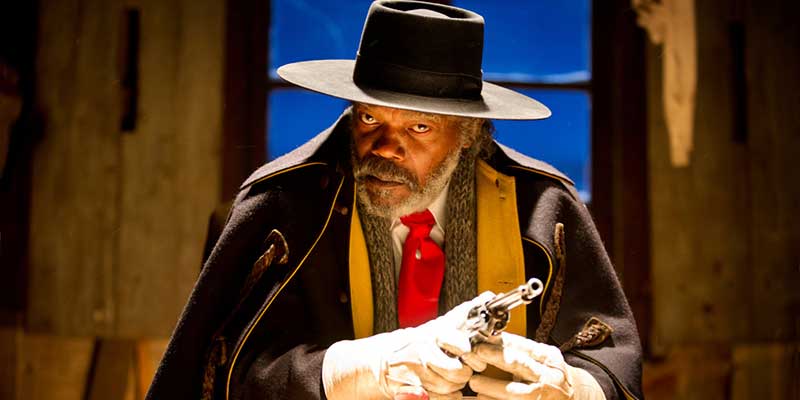
Samuel L. Jackson in THE HATEFUL EIGHT.
But, he still likes to keep count. So, in keeping with that, here’s eight reasons why the 70mm “Roadshow” version of The Hateful Eight delivers:
1. It’s cinema nirvana. The opening titles alone give any film nerd dorky goosebumps. In one of the stronger cases in recent times of the medium itself being the message, as viewers are immediately greeted with such unseen relics as the Cinerama logo, and a credit informing that the movie’s shot in Ultra Panavision 70. In a film that’s story hinges so tightly on lies and deceit, that last bit is actually very true. Before all of that, at the absolute start, there’s even an Overture that goes on for several minutes, allowing audiences to really settle in. It’s just like in the old days, when moviegoers would get dressed up to attend a cinematic roadshow exhibition.
Just as “Kill Bill” educated many about the work of the Shaw Brothers, and “Pulp Fiction” turned on a new generation to the French New Wave and crime cinema, “The Hateful Eight” boldly recreates a tactile, long gone phase of Hollywood showmanship.
Just as the theatrical roadshow event movies were originated to compete with the 1950s onslaught of television and air conditioning, the notoriously technology-hating director of this film seems to realize that today more than ever, the same issue looms, only tenfold. If putting on a massively scaled throwback spectacle in a handful of cinemas in a given country is what it takes to tear people away from their smartphones and instant streaming services, leave it to Tarantino to insist that it happens. And here, it’s happening his way.
And, it’s true that any dyed-in-the-wool film buff is also a fan of Westerns, as it’s so critically intertwined with cinema’s evolution. Which is why it’s great that:
2. The Western is back! In a world where Westerns are considered passé, it’s interesting that the most buzzed-about films of the current cultural moment are either Westerns, or are highly derivative of Westerns. Besides this film, there’s Innuritu’s outdoor survival epic The Revenant (which tops The Hateful Eight is the visceral violence department), and The Force Awakens, which, as all Star Wars films do, has it’s roots in John Ford and company.
3. Robert Richardson. Let’s just take a minute and recognize the vital role that this bold and daring cinematographer plays in Quentin Tarantino’s celebrated world-building and visual realizations. Crafting the mood of the piece as any good cinematographer does, Richardson, the onetime DP for some of Oliver Stone’s most visually daring work (JFK, Natural Born Killers), continues to push boundaries in his field, this time by looking effectively backwards. Richardson’s instant mastery of the vintage Ultra Panavision 70 camera packages, restored and put back into the field for the first time since they were mothballed in the mid-1960s, is spectacular to behold. Why go to this considerable effort to realize a film that’s mostly indoors and talking with equipment best suited for capturing the re-enacted fall of Rome? Light, shadow and color dance together within the vast widescreen frame, something previously left to the era of How the West was Won and Ben-Hur.
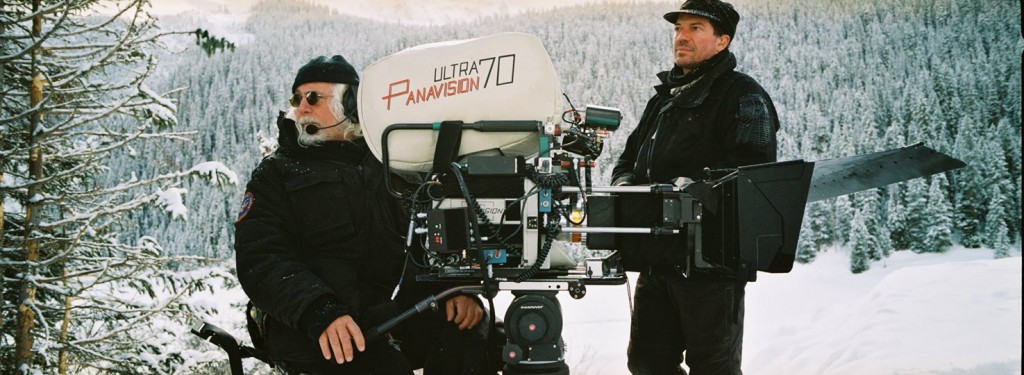
Cinematographer Robert Richardson on location with the resurrected 70mm camera gear.
4. New Ennio Morricone. NEW ENNIO MORRICONE!!! Okay, to be fair, Morricone, now in his late eighties, hasn’t exactly gone dormant. A quick look at his composer filmography shows plenty of new work – just not anything nearly as prominent as this for quite some time. The celebrated maestro of so many iconic Western and Giallo scores, including The Good, the Bad, and the Ugly and Once Upon a Time in America, as well as more dramatically rooted material as Roland Jaffe’s The Mission, has seen his existing work sampled several times prior by Tarantino. And, his past work is also sampled here (Exorcist II cues and unused music from The Thing are reported used). The many Morricone catalog inclusions in Kill Bill, Inglourious Basterds, and others have already proven that the individual creators are two great tastes that taste great together. With The Hateful Eight, Tarantino having reached out for Morricone for an actual original score demonstrates a certain evolution on his part, beyond his masterful reliance on “needle drop” tunes. For Morricone, his work is being hailed as his triumphant return to the Western genre – and an undeniable highlight of the film.
5. There’s an intermission. No need for that “When to Pee” app – The Hateful Eight has a mercifully built-in intermission just beyond the midway point. For Tarantino die-hards, this is especially handy, considering that the second half is when the action truly picks up, placing this segment of the audience at greater risk of wetting themselves. And additionally, just think of how pissed this notoriously luddite director would be if he caught you looking at a smartphone during his film! The snack bar will be open. Just beware of the coffee…
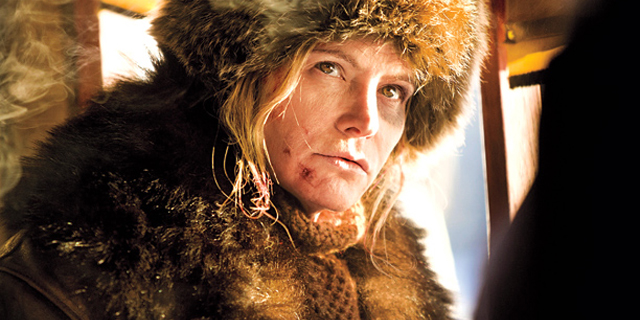
Jennifer Jason Leigh knows hate…
6. The Hateful Eight +. Samuel L. Jackson. Kurt Russell. Tim Roth. Michael Madsen. Zoe Bell. This collection of Tarantino all-stars who’ve assembled for this film is something to behold. Toss in a few natural newcomers (Bruce Dern, Walton Goggins, Jennifer Jason Leigh… even Channing Tatum has his shot!), and you might just be looking at the best ensemble of the year. A quick headcount of every character in the first half reveals that there are in fact more than eight raspy varmints populating the remote outpost known as Minnie’s Haberdashery. Part of the fun at intermission is speculating who’s hateful and who isn’t. But, hateful or not, all are solid in their hateful-or-not roles.
7. Tarantino isn’t in it. Well, that’s not quite true. His actual voice is heard in a few brief moments, acting as a narrator, to accompany his artistic voice. But thankfully, he was able to resist that gawd-awful urge he succumbs to all too often to take a small role in his movies. His role in The Hateful Eight might mark the first time his presence in a film – any film – is actually welcome.
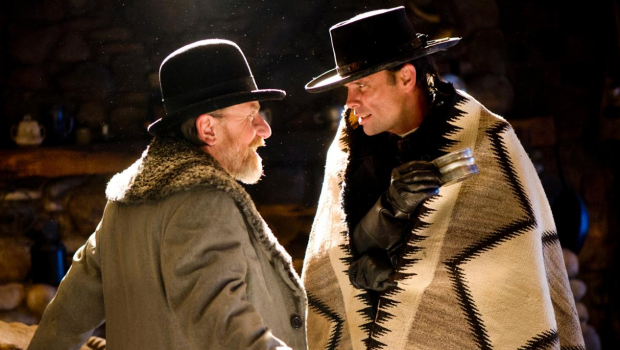
More Hate.
8. Time & Place. As Quentin Tarantino has gone on as a filmmaker, perhaps the most noticeable aspect of growth has been his commitment to the time periods he chooses to depicts. Whether it’s the American deep South of “Django Unchained”, the unrest of World War II felt in “Inglorious Basterds”, or even the fantasy-infused world of “Kill Bill”‘s look into old world Japan and dusty Mexico, it’s clear that the man has done his homework. With each effort, Tarantino has been able to infuse the eras and places of his choosing with his own trademark style, dialogue and sensibility. The blending has yet to fail.
8 ½. It’s the eighth film from Quentin Tarantino. By resurrecting both the roadshow Western, Tarantino is successfully evoking both the post-U.S. Civil War period in which the story takes place, and a unique mid-century filmgoing experience, the time when Western films flourished. If you have the opportunity to attend the film in its longer and larger authentic 70mm roadshow format, and if you’re a fan of the director, absolutely don’t miss out. And if the non-roadshow version is the only game in your town, go anyway. While by no means his best movie, The Hateful Eightmore than satisfies any nagging itch for new work from this uniquely recognizable voice.
Count on it.

